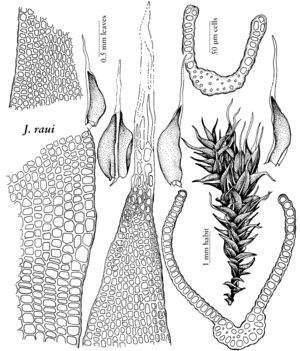Jaffueliobryum
Rev. Bryol., n. s. 1: 192, plate 8, figs. 1–5. 1928 ,.
| Taxon | Illustrator ⠉ | |
|---|---|---|
 | Jaffueliobryum raui | Patricia M. Eckel |
 | Jaffueliobryum wrightii | Patricia M. Eckel |
Plants 3–15 (–20) mm, in dense cushions, dark olive, yellow-green, or dull green to olivaceous. Leaves broadly ovate to obovate, concave or somewhat keeled, margins plane, smooth or weakly serrate to erose distally, distal lamina mostly 1-stratose, rarely with 2-stratose streaks, specialized laminal and marginal chlorophyllose structures absent, awn short to twice lamina length, distal leaves typically with longer awns; basal-cells elongate-rectangular to oblong, with straight, somewhat lax, sometimes weakly hyaline walls; mid leaf and distal cells isodiametric, oval to irregularly rhomboidal; distal cells becoming hyaline with age. Gemmae absent. Sexual condition autoicous or rarely cryptoicous; perichaetial leaves enlarged, long-awned. Seta short, straight. Capsule erect, immersed, symmetric, globose to ovoid; annulus differentiated, typically persistent; operculum conic, short to long-rostrate, falling detached from columella. Calyptra campanulate, mitrate, sometimes erose or lobed at base, large, covering 1/2–3/4 of capsule, plicate.
Distribution
North America, Mexico, South America (Bolivia), c Eurasia (China), c Eurasia (Mongolia), c Eurasia (Russia)
Discussion
Species 3 (2 in the flora).
Jaffueliobryum is distributed in cold to hot and arid regions, and usually is found on calcareous rock. It appears to be closest to Coscinodon, from which it differs by the broader, less strongly keeled, mostly 1-stratose leaves, strictly autoicous-cryptoicous sexuality, and calciphilous ecology. The third species, J. arsenei (Thériot) Thériot, larger than our species, is endemic to Mexico and is characterized by a long-rostrate operculum and an exserted capsule.
Selected References
Lower Taxa
Key
| 1 | Distal lamina acute to acuminate, leaves distinctly keeled, proximal stem leaves mostly spreading | Jaffueliobryum raui |
| 1 | Distal lamina broadly acute-rounded, leaves not keeled, proximal stem leaves mostly appressed | Jaffueliobryum wrightii |
"short" is not a number.